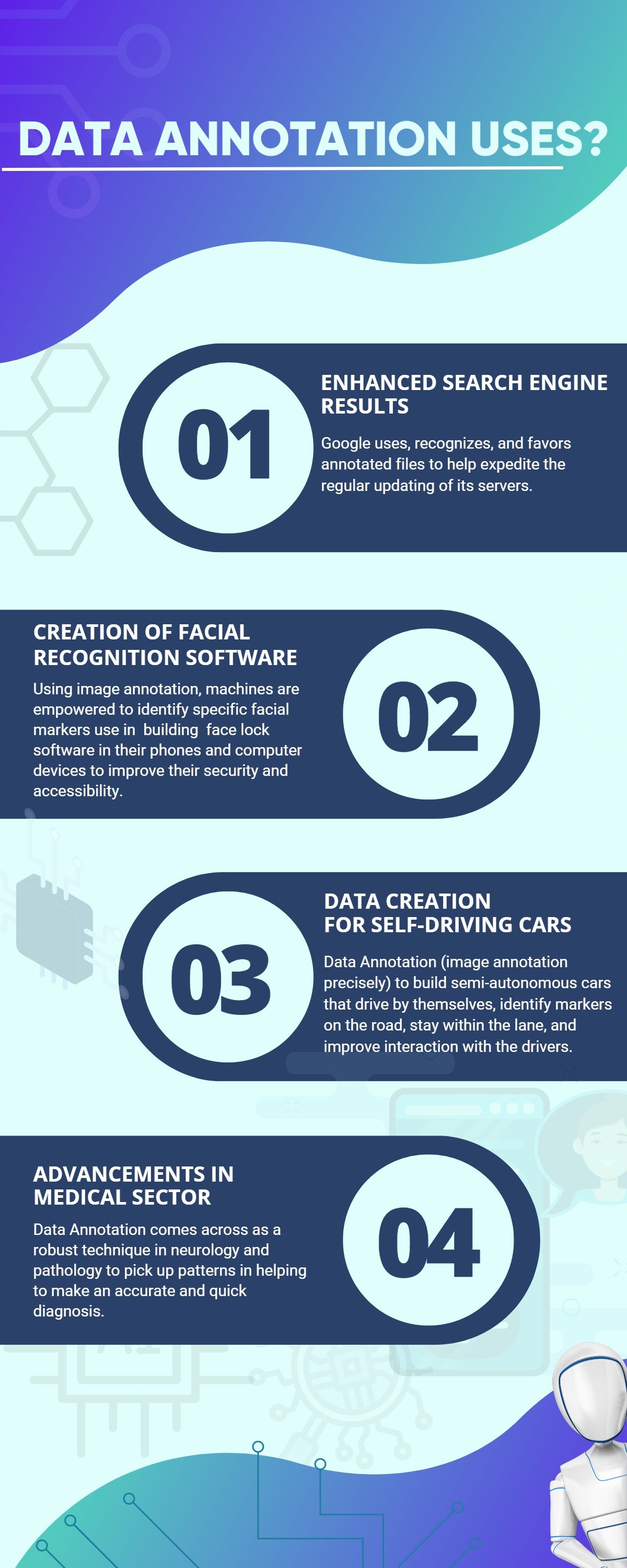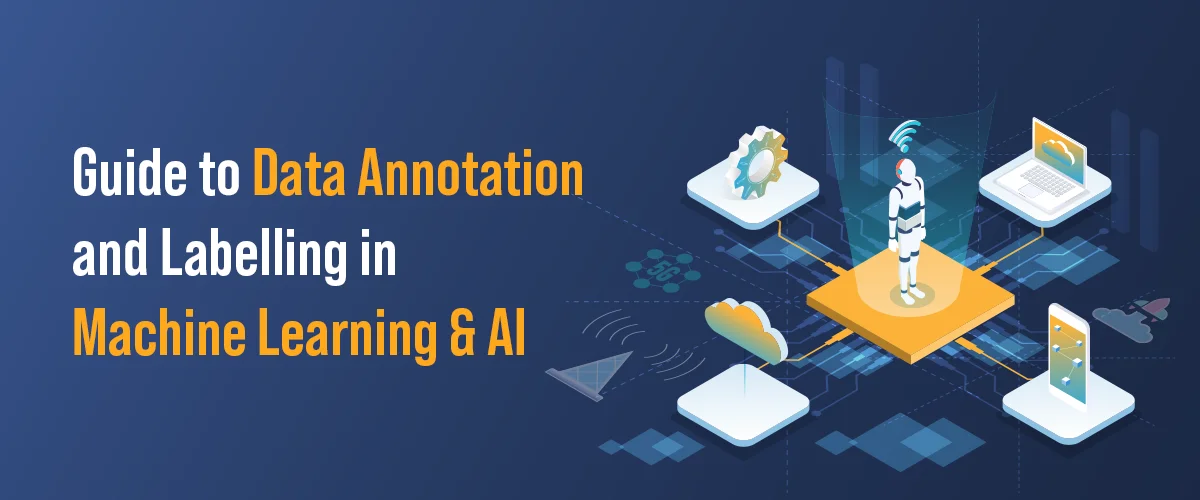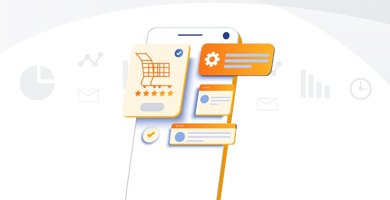Introduction
Ever since the inception of Artificial Intelligence (AI) and Machine Learning (ML), there’s hardly any industry that has been left untouched by the benefits and the superlative innovation offered by them. It’s incredible to fathom how machines can learn and perform similarly as us humans.
While AI and ML have a long-standing history, organizations have now warmed up to their massive contribution to real-life systems. However, a majority of businesses still struggle to understand the entire concept of AI and ML to have an edge over their competitors.
Implementation of artificial intelligence in any sector requires expertise in data collection, categorization, filtering, labelling, and annotation techniques. To put your worries behind us, we’ve compiled a comprehensive guide to Data Annotation and labelling helping you learn what it is, how it is done, why it is needed, Data Annotation examples, and types of Data Annotation. Let’s dive right in!
What is Data Annotation?
A large majority of data owned by organizations is unstructured and is growing manifold with each passing year. Large chunks of unstructured data floating around pose security and compliance risks. This is where Data Annotation steps in!
Data Annotation is the cumulative process of tagging and labelling the available, unstructured data into different elements like text, images, videos, and more. When we end up labelling the data elements, it’s easy for machine learning models to accurately comprehend and process those elements even in the future when any new information is built on the existing data.
When your data is appropriately annotated and implemented, the efficiency of your AI and ML models increases automatically. Such models are perfectly ready to take up for deployment for chatbots, automation, speech recognition, and more such processes.
What are the Differences Between Data Annotation and Data Labelling?
In the terms of machine learning, both Data Annotation and data labelling are actually the same – the process of tagging meaningful labels to the unstructured datasets to help explain what’s inside them. Let’s look at Data Annotation vs data labelling in a different manner:
| Parameter | Data Annotation | Data Labelling |
| Overview | Data Annotation is the processing of adding relevant labels to the data to make them recognizable and understandable by machine learning models. | Data labelling is the precise process of adding additional information/metadata to existing unstructured data to help train machine learning models. |
| Purpose | Data Annotation is a basic requirement when it comes to training different machine learning models. | Data labelling serves the purpose of identifying relevant features in a particular dataset. |
| Benefit | Data Annotation benefits by helping in recognizing relevant data. | Data labelling benefits in recognizing the patterns to help train ML algorithms and models. |
Types of Data Annotation
Types of Data Annotation is a broad term encapsulating multiple Data Annotation examples, such as image, text, video, audio, and more. For a clear understanding, we’ve fragmented them individually. Let’s learn different Data Annotation examples and types:
- Image Annotation
Image annotation is a crucial technique in modules concerning facial recognition, computer vision, robotics, and more. AI experts add labels such as captions, identifiers, attributes, tags, and keywords inside the image to make it easier for robotics to comprehend the visual information. The techniques used in image annotation include bounding boxes, line annotation, 3D cuboids, and landmark annotation.
- Text Annotation
Text data comes with a lot of semantics and contrast to images and videos that convey a straightforward intention. Text-based data could be anything, ranging from customer feedback on the app/website to a social media mention. While humans are attuned to understanding the context, relatability, conversation, and meaning behind a text, machines are unable to do so.
Abstract elements in data like sarcasm, humour, and emotion are an unknown territory for machines, which is why text annotation is further staged in a more refined manner:
- Semantic Annotation
- Intent Annotation
- Text Categorization
- Named Entity Annotation
- Relation Annotation
- Audio Annotation
Audio annotation is the process of timestamping, audio labelling, and transcribing speech data. Audio annotation, being an umbrella technique, covers speech transcription, pronunciation, and going a mile further by identifying the speaker's dialect, demographics, and language.
- Video Annotation
Video annotation is a process involving the addition of key points, bounding boxes, and polygons to annotate or label different objects in each video frame. For the unversed, video is a compilation of different images creating the effect of being in motion, and each image in the moving video is referred to as a frame. Video annotation helps in localization, object tracking, and motion blur in different systems.
Data Annotation Use Cases

- Enhanced Search Engine Results
Building your website and putting it on the search engines like Google or Bing is challenging since millions of websites and pages already exist. Google uses, recognizes, and favours annotated files to help expedite the regular updating of its servers.
When fed to the search engines, data sets with appropriate Data Annotation help improve the quality of the search results. Data Annotation makes it easier to fetch customized search results of a user’s query based on the user history, gender, age, demographics, and more.
- Creation of Facial Recognition Software
Using landmark annotation in image annotation, machines are empowered to identify specific facial markers such as the nose, shape of the eyes, face length, and more. Such facial recognition pointers are then stored in a computer database to help identify them if the face comes into sight later.
This technology has empowered leading tech companies like Samsung and Apple to build face lock software in their phones and computer devices to improve their security and accessibility.
- Data Creation for Self-Driving Cars
Companies like Tesla has harnessed the power of Data Annotation (image annotation precisely) to build semi-autonomous cars that drive by themselves, identify markers on the road, stay within the lane, and improve interaction with the drivers. Bounding boxes, 3D cuboids, and semantic segmentation techniques are used in creating Tesla for lane detection, collection, and identification of objects.
- Advancements in Medical Sector
New technology and breakthrough advancements in the healthcare sector are largely based on artificial intelligence. Data Annotation comes across as a robust technique in neurology and pathology to pick up patterns in helping to make an accurate and quick diagnosis. Doctors can now identify malignant cells and cancerous tumours that are challenging to identify visually.
Final Thoughts
Data Annotation types and use play a catalyst in the development of artificial intelligence and machine learning. If you’re looking for dependable and accurate Data Annotation and labelling services for your upcoming projects, nudge us to witness how our Data Annotation services are all geared up to improve the quality of your systems, save time, money, and effort, and help make your businesses and projects scale while keeping with the trends. Reach out to us now!








